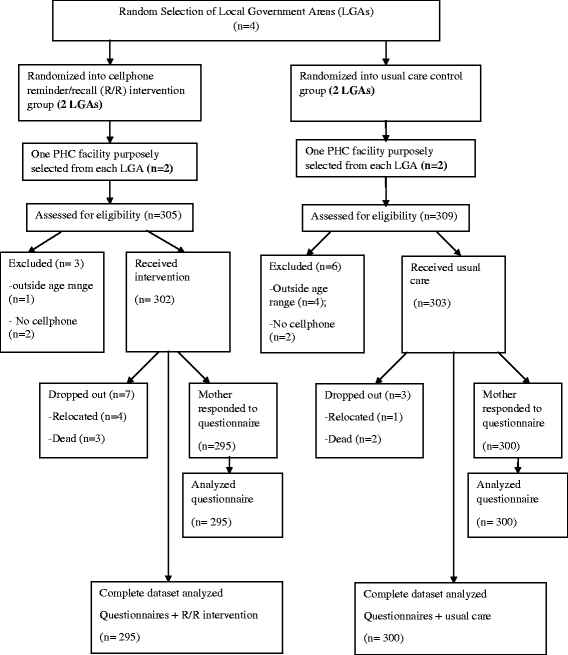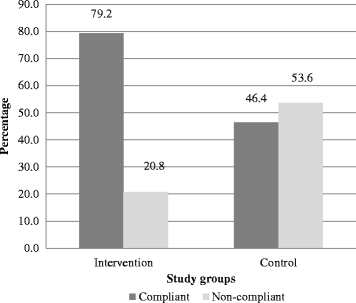Feasibility of implementing a cellphone-based reminder/recall strategy to improve childhood routine immunization in a low-resource setting: a descriptive report
- PMID: 29219093
- PMCID: PMC5773899
- DOI: 10.1186/s12913-017-2639-8
Feasibility of implementing a cellphone-based reminder/recall strategy to improve childhood routine immunization in a low-resource setting: a descriptive report
Abstract
Background: Reminder/recall systems are effective ways to improve immunization rates, but their feasibility in primary health care (PHC) settings in Nigeria has not been adequately evaluated. In this study we describe the acceptability and adaptability of immunization reminder/recall system in an urban setting in southwest Nigeria.
Methods: This is a descriptive report of a cluster randomized controlled trial. Four local government areas (LGAs) were randomly assigned into a cellphone reminder/recall intervention group or a usual care control group. Within each LGA, PHC centers were purposively selected to participate in the study. In each PHC center, mothers and their infants aged 0-3 months were enrolled into the two groups during the infants' first immunization visit. Mothers (or other contact persons) in the intervention group received cellphone calls reminding them to take their child for scheduled immunizations. Follow-up of all the children lasted till the final scheduled immunization visit for each child. The intervention lasted for 13 months.
Results: A total of 595 mothers/infants pairs (295 in the intervention group and 300 in the control group) participated in the study. Almost all mothers (n = 590, 99.2%) had access to their own cellphone or had access to a cellphone belonging to a significant other. Ninety-eight percent (n = 584) of all mothers were willing to receive immunization reminder/recall phone calls. Eighty-seven percent (n = 2023) of all calls (n = 2324) for the reminder/recall intervention went through to the recipients and of these calls, 1948 (96.3%) were received. The mean cost of each call in US Dollars was about 5 cents. Immunization compliance rate (the receipt of required number of doses of routine vaccines at the appropriate age at recommended interval) was 79.2% among the children in intervention group and 46.4% in the control group (p < 0.001).
Conclusion: Results demonstrate that cellphone reminder/recall interventions to improve routine childhood immunization are feasible in PHC settings in limited-resource settings with wide cellphone coverage, such as urban areas in Nigeria. Further research to test the potential for scale up in a variety of settings is recommended.
Trial registration: PACTR201702002043415 ; Date of registration: 17 February 2017. (Retrospectively registered).
Keywords: Acceptability; Adaptability; Childhood; Effectiveness; Immunization; Reminder/recall.
Conflict of interest statement
Ethics approval and consent to participate
Ethical approval for the main study was obtained from the Oyo State Research Ethical Review Committee (Approval Number: AD 13/479/209). All mothers provided signed informed consent prior to participating in the study.
Consent for publication
Not applicable.
Competing interests
The authors declare that they have no competing interests.
Publisher’s Note
Springer Nature remains neutral with regard to jurisdictional claims in published maps and institutional affiliations.
Figures
References
-
- World Health Organization . Children: reducing mortality. 2013.
-
- United Nations Children’s Fund (UNICEF) Levels and trends in child mortality report 2011: estimates developed by the United Nations inter-agency group for child mortality estimation. New York, USA: UNICEF; 2011. pp. 3–5.
-
- National Center for Immunization and Respiratory Diseases General recommendations on immunization: recommendations of the advisory committee on immunization practices (ACIP) MMWR Recomm Rep. 2011;60(2):1–64. - PubMed
-
- World Health Organization . World immunization week 2013: protect your world - get vaccinated: origins the campaign, public health context. Switzerland: WHO; 2013.
Publication types
MeSH terms
LinkOut - more resources
Full Text Sources
Other Literature Sources
Miscellaneous



